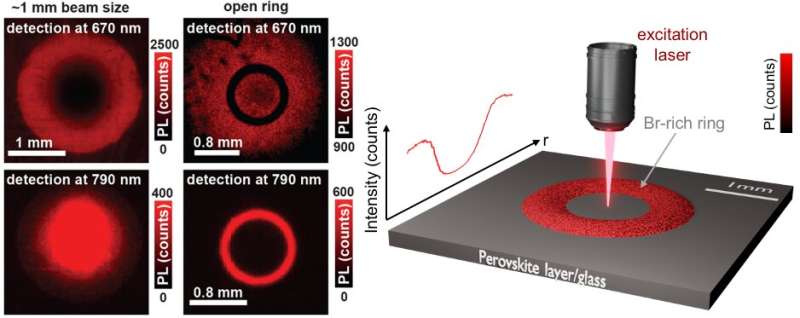Photo-induced ion displacement in mixed-halide perovskites for a battery directly chargeable by light

Lead halide perovskites (e.g., MAPbI3) are an emerging family of semiconductor materials with excellent optoelectronic properties ideally suited for photovoltaic and light-emitting applications. Significant ion migration has been reported in these materials and is one of the main mechanisms responsible for anomalous I-V hysteresis and poor stability in the perovskite solar cells.
Particularly, mixed halide perovskites further exhibit photoinduced halide anion "segregation" under continuous above-bandgap illumination, and the process is reversible when the illumination is removed. This segregation phenomenon is commonly viewed as an adverse effect to the optoelectronic applications and should be suppressed.
The most observed effect of the ion segregation is the red shift in photoluminescence (PL) peak from the expected wavelength for the alloy to that of a significantly higher composition of Iodine. It is generally asserted that a uniform alloy MAPbI1-xBrx would segregate into Iodine-rich and Bromine-rich domains within the illuminated area.
A number of microscopic mechanisms have been proposed to explain the phenomenon. However, none of them can unambiguously explain all the key aspects of the phenomenon. In fact, the chemical and structural characteristics of the so called "Br-rich" and "I-rich" regions are not yet well understood, although they are implicitly assumed to be simply Br-rich and I-rich alloys, respectively.
In a new paper published in Light: Science & Applications by scientists from Empa−Swiss Federal Laboratories for Materials Science and Technology, Switzerland, The University of North Carolina at Charlotte, USA, and Tsinghua University, China have discovered that the anion segregation in the mixed halide alloy is a nonlocal effect of which the ion redistribution may occur in a macroscopic or mesoscopic scale far beyond the illuminated area in a scale proportional to the illumination beam size, up to well over mm. This work offers a completely new perspective to the generally assumed photo-induced "on-site" anion segregation in mixed halide perovskite alloys.
The authors state that "specifically, we find that under illumination, within the illumination area, the PL peak is red shifted from the initial position; while concurrently, outside the illuminated area, the alloy PL peak is strongly enhanced in a ring area circling the illuminated area. Furthermore, the process is reversible, but non-monotonically, exhibiting ultra-low-frequency damped oscillations between the ring and center in terms of PL intensity and position."
"These surprising observations can be explained as that free Br ions are expelled from the illuminated area, resulting in a positively charged area, and concomitantly forming a negatively charged Br-rich ring, both being off stoichiometry from the original alloy. This phenomenon can be viewed as an ionic analogy of a mesoscopic PL ring formation away from the illuminated site in GaAs/AlGaAs quantum wells, resulting from the disparity in the electron and hole diffusion lengths and thus their spatial profiles," they added.
The authors suggest that the peculiar oscillatory behavior could reflect an oscillation of ionic plasma or ionic plasmon, which has not been reported in solids. Besides the broader implications beyond the field of the halide perovskites, these findings offer new insights into the underlying mechanism of the ion segregation in the mixed halide alloys, which makes it not necessarily an adverse phenomenon to suppress but something potentially useful, e.g., for energy storage. As a promising demonstration, a voltage around 0.4 V was measured between the center and ring, pointing to the possibility of a battery that can be directly charged by light.
More information: Xiaoxiao Sun et al, Photo-induced macro/mesoscopic scale ion displacement in mixed-halide perovskites: ring structures and ionic plasma oscillations, Light: Science & Applications (2022). DOI: 10.1038/s41377-022-00957-8
Journal information: Light: Science & Applications
Provided by Chinese Academy of Sciences




















